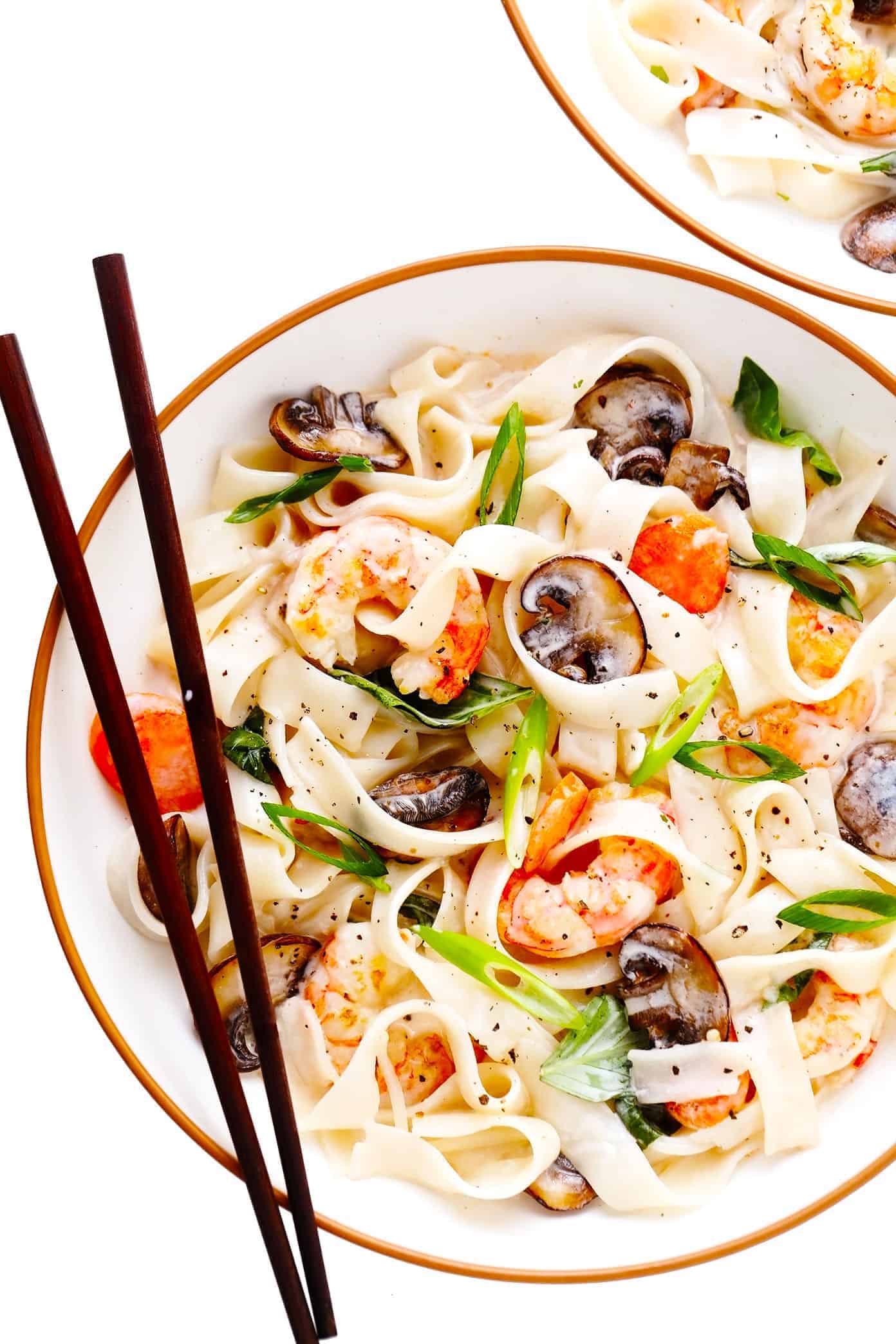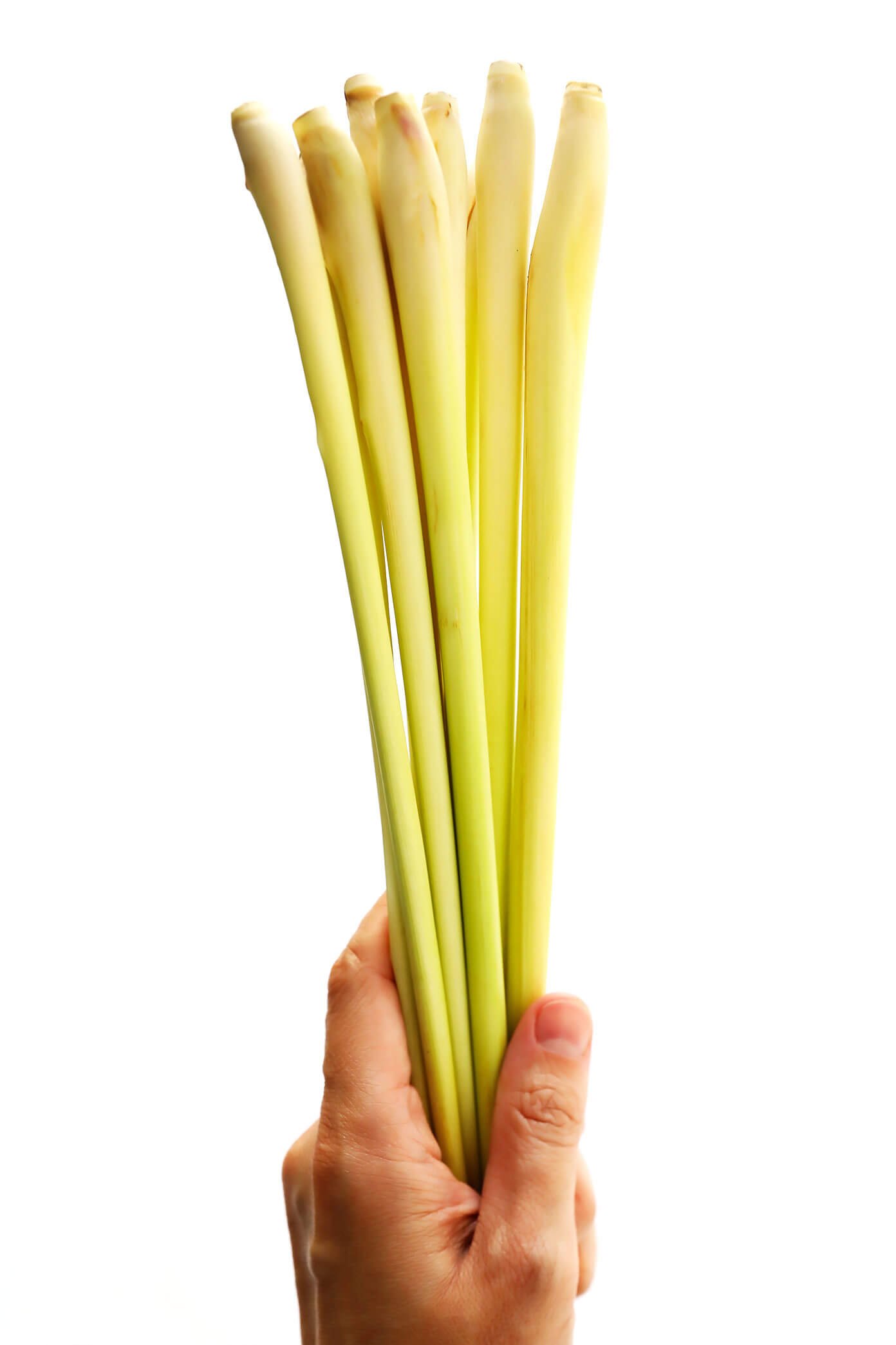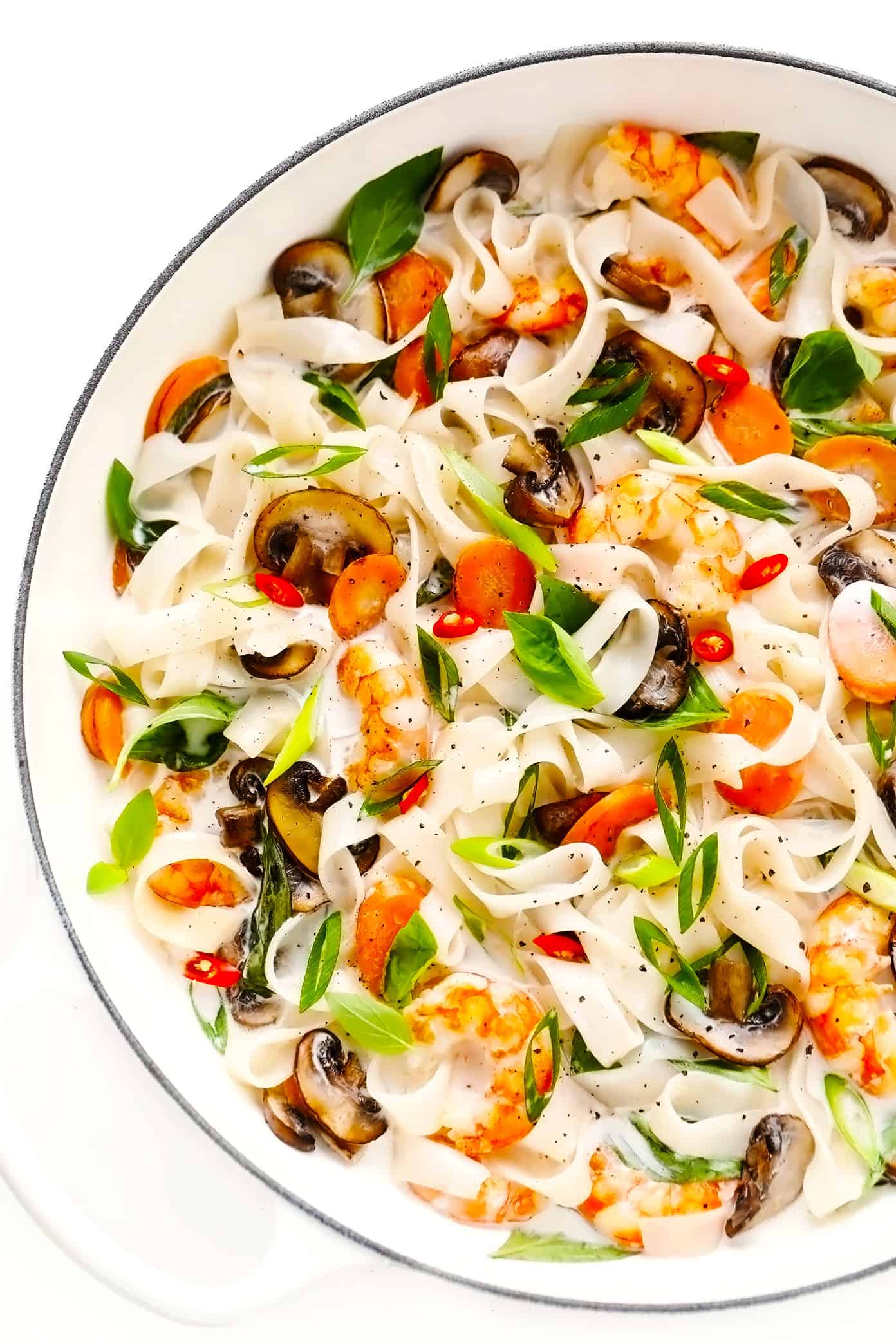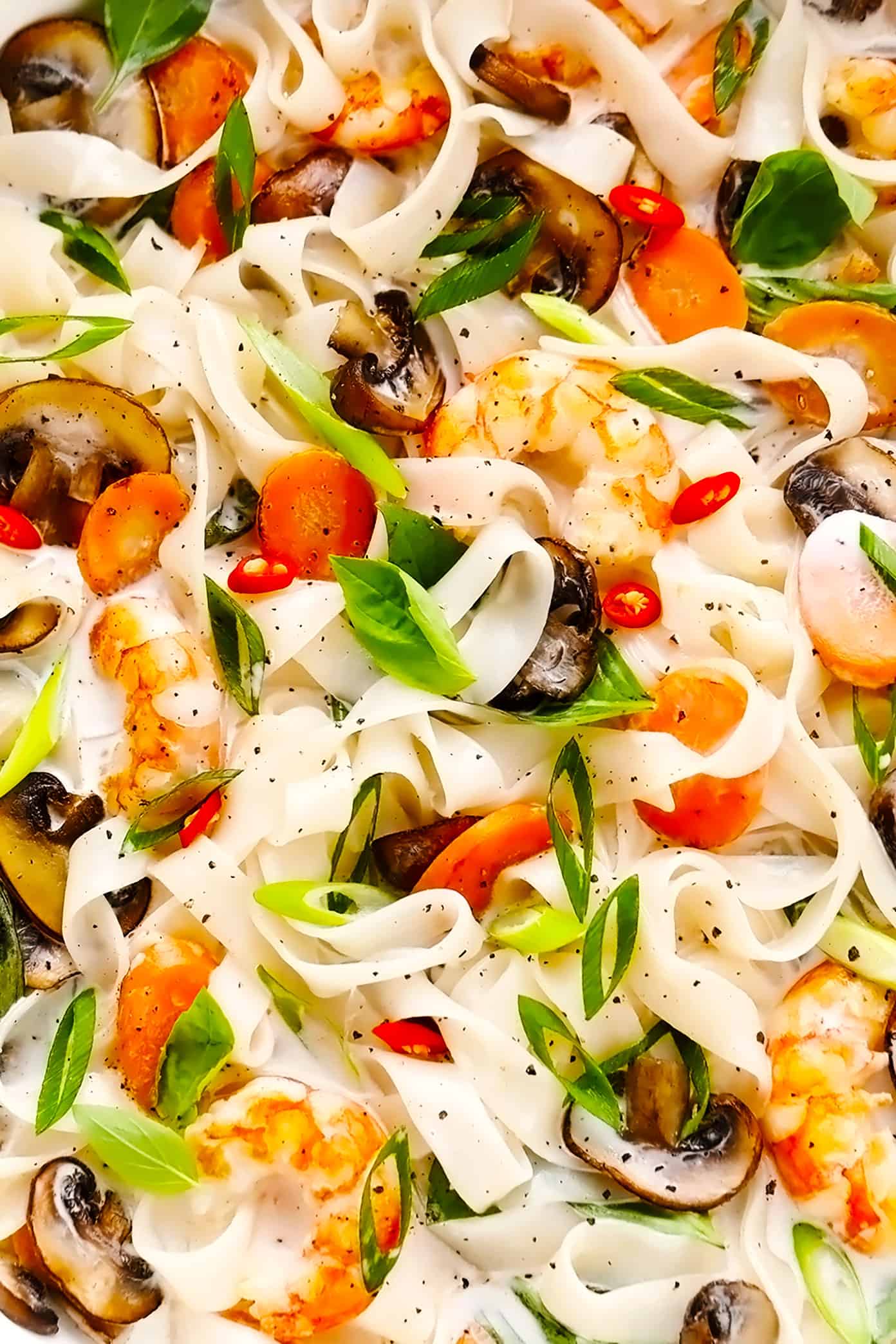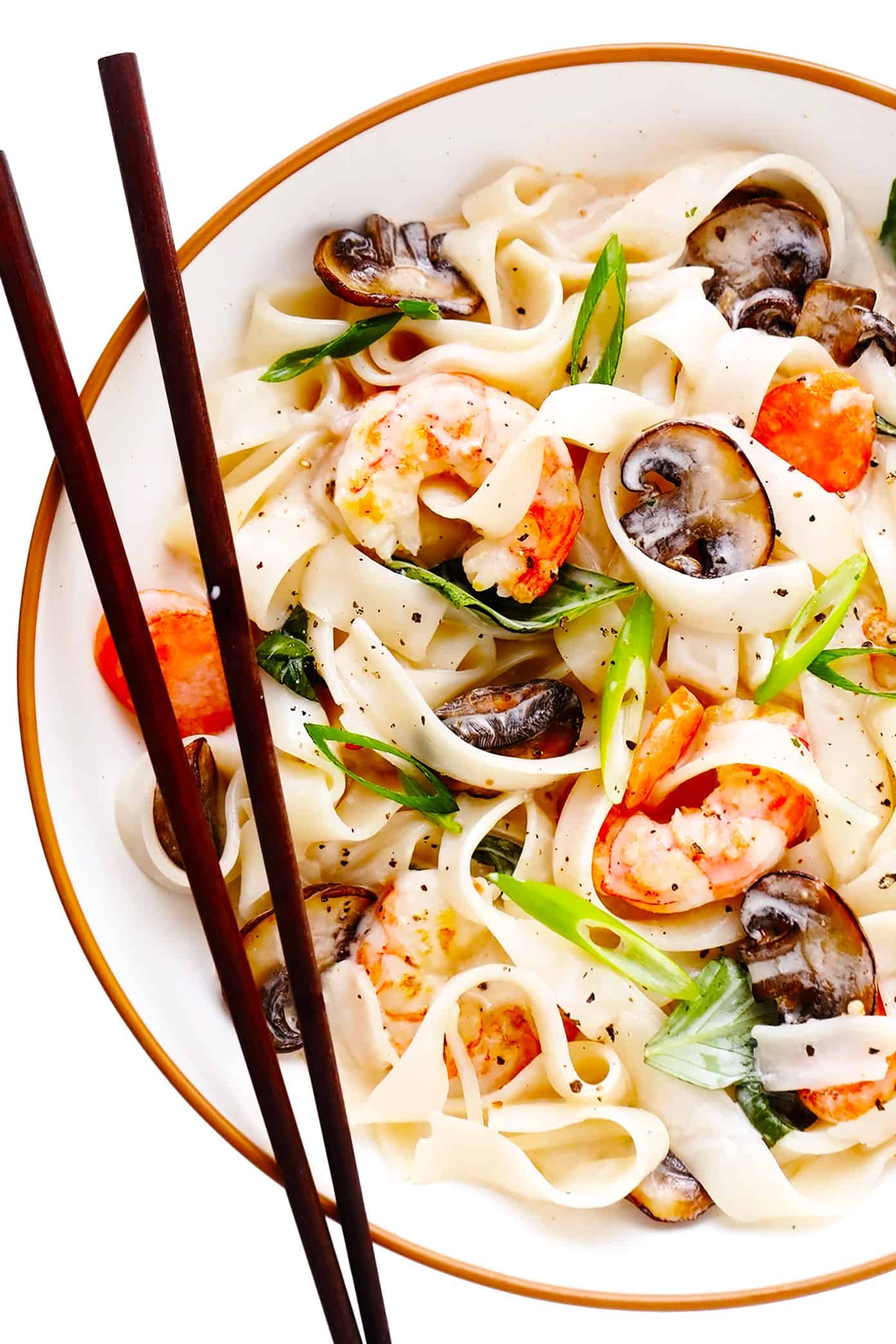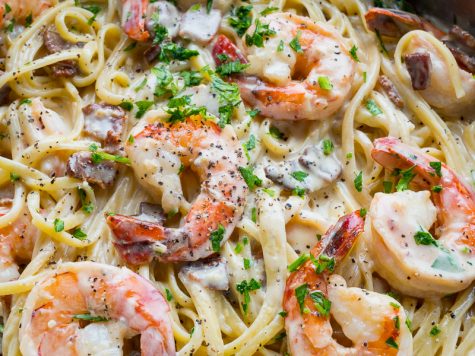This post may contain affiliate links. Please read my disclosure policy.
This Thai-inspired noodle stir-fry is tossed with fresh veggies, tender shrimp, and a zesty lemongrass coconut sauce. Easy to make and full the best bright and citrusy flavors!
Say hello to the lemongrass coconut noodle stir-fry that we have been loving here lately. ♡
It’s loosely inspired by Thai tom kha (coconut soup), which happens to be my husband’s all-time favorite soup and one that we’ve both been craving lately now that it’s finally cooling off and feeling like autumn here in Barcelona. Instead of simmering those classic creamy, citrusy, earthy, sweet and slightly-spicy flavors into a big pot of soup broth, though, they are condensed into a rich coconut stir-fry sauce and tossed with a simple stir-fry and rice noodles for this recipe. And the end result is bursting bright, fresh flavors and absolutely delicious.
Fresh lemongrass — with its uniquely citrusy, minty, earthy flavor — is the starring ingredient in this coconut sauce and one that you definitely won’t want to skip. So the next time you’re at the market, be sure to pick up a few stalks of fresh lemongrass or a tube of lemongrass paste to brighten up that creamy coconut milk sauce. Along with it, we will simmer a generous amount of fresh ginger, the juice of one fresh lime, your desired amount of brown sugar and a splash of fish sauce for extra umami flavor. To be sure, this list of ingredients is notably different than those used in the broth of authentic Thai tom kha gai (which traditionally uses galangal in place of ginger, kaffir limes in place of fresh lime juice, palm sugar in place of brown sugar, etc — any of which I would completely encourage you to sub into this lemongrass coconut sauce recipe if you’d like). I initially just improvised this recipe one evening with the ingredients that I already happened to have stocked in my kitchen, so the recipe is written accordingly below.
Since my husband is pescatarian, we’ve typically been turning to shrimp as the main protein for our stir-fry. But the lemongrass coconut sauce recipe included here is actually completely vegan (also gluten-free), so feel free to swap in crispy tofu to make this recipe completely plant-based, or you can of course substitute any other meat in place of the shrimp, such as chicken, steak or pork. Feel free to also toss in whatever veggies you love best that happen to be hanging out in your crisper drawer. And if you can, I highly recommend tracking some some fresh Thai basil to fold into the stir-fry too — it’s optional but so, so good.
Alright, grab that lemongrass and let’s get to stir-frying!
Lemongrass Noodles Ingredients:
Before we get to the full lemongrass coconut noodles recipe below, here are a few notes about the ingredients that you will need:
- Rice noodles: I used wide rice noodles in the version photographed here, but any width of rice noodles that you prefer will work. (Or alternately, you can also just serve this stir-fry over rice.)
- Shrimp: Whichever size of shrimp you prefer, peeled, deveined and seasoned with a few twists of salt and pepper.
- Veggies: I went with a simple mix of baby bella (or you could use shiitake) mushrooms, carrots and garlic. But feel free to use whatever stir-fry-friendly veggies that you have on hand.
- Thai basil leaves: I highly, highly recommend picking up some Thai basil, which adds the most delicious sweet, peppery, anise-y flavor to this stir-fry. But if you cannot find any, you are welcome to use sweet basil in its place, or just omit it completely and add in extra fresh cilantro instead.
- Lemongrass: I used a few stalks of fresh lemongrass in the sauce, whose ends need to be trimmed off and the outer layers peeled and discarded. (The inner white layers are where the most flavor resides!) Roughly chop the stalks into 1/2ish-inch chunks, simmer them in the sauce, and strain out before serving. Alternately, you can add in a few tablespoons of lemongrass paste instead, which will not need to be strained out before serving.
- Coconut milk: I really recommend using a can of good-quality, full-fat coconut milk for this sauce in order to make it extra creamy and thick. But if you would like to lighten things up, you’re welcome to use low-fat coconut milk instead.
- Fresh ginger: We will very thinly slice a few inches of fresh ginger into long strips to simmer in the coconut milk. You are welcome to peel the ginger before slicing it if you’d like, but I typically skip that step since we will be straining out the solids from the sauce in the end anyway.
- Brown sugar: I just used a tablespoon of basic light brown sugar to lightly sweeten the sauce, but feel free to use whatever sweetener you prefer. If you would like a sweeter sauce, you’re of course welcome to increase the amount of sweetener too.
- Lime juice: We will add the juice of one lime to the sauce, but I recommend also serving each bowl of noodles with an extra lime wedge or two for drizzling.
- Fish sauce: We will add a tablespoon (or you can add more, if you’d like) to the sauce for that extra tangy, salty, umami kick.
- Garnishes: Finally, I highly recommend adding a generous sprinkling of thinly-sliced green onions and fresh cilantro (and/or extra Thai basil) to each serving bowl. If you want to add some spice, you can also toss in a few thinly-sliced Thai bird chiles (or crushed red pepper flakes). And as mentioned above, I also recommend serving each bowl with an extra lime wedge or two for an extra-tangy finish.
Optional Variations:
Here are a few other ways that you could customize this lemongrass noodles recipe:
- Use different veggies/greens: Feel free to add in any other stir-fry-friendly veggies or greens that might sound good here in place of (or in addition to) the mushrooms or carrots. For example, asparagus, broccoli, bell peppers, snow peas and/or spinach would all be great here.
- Use a different protein: Chicken, steak, pork, sausage or tofu would all be delicious options in place of the shrimp.
- Use low-fat coconut milk: You’re welcome to swap low-fat coconut milk in place of full-fat coconut milk to lighten the sauce up a bit. Just note that it will not be nearly as thick and creamy.
- Use rice: Instead of tossing the stir-fry with rice noodles, you’re welcome to just serve the shrimp, veggies and lemongrass coconut sauce over your choice of rice.
More Favorite Noodle Recipes:
Here are a few more favorite noodle recipes to try too!
Description
This Thai-inspired noodle stir-fry is tossed with fresh veggies, tender shrimp, and a zesty gingery lemongrass coconut sauce. Easy to make and full the best bright and citrusy flavors!
Noodle Stir-Fry Ingredients:
- 9 ounces rice noodles
- 1 pound large shrimp, peeled and deveined
- fine sea salt and freshly-cracked black pepper
- 3 tablespoons olive oil, divided
- 8 ounces baby bella or shiitake mushrooms, sliced
- 1 large carrot, thinly sliced
- 4 cloves garlic, minced
- 1 cup (lightly-packed) Thai basil leaves*
- garnishes: thinly-sliced green onions, lime wedges, thinly-sliced Thai bird chiles (or crushed red pepper flakes), fresh cilantro and/or extra Thai basil
Lemongrass Coconut Sauce Ingredients:
- 2 stalks fresh lemongrass,*
- 1 (15-ounce) can full-fat coconut milk
- 2 inches fresh ginger, thinly sliced into long strips
- 1 tablespoon brown sugar
- 2 to 4 tablespoons fresh lime juice, to taste
- 1 tablespoon fish sauce
- Prepare the lemongrass coconut sauce. Peel and discard the outer layer of the lemongrass stalks, slice off and discard the ends, then roughly chop the remaining stalks into 1/2-inch pieces. Combine the lemongrass, coconut milk, sliced ginger, lime juice and brown sugar in a medium saucepan. Heat over medium heat until the sauce almost reaches a simmer. Reduce heat to low, cover, and continue cooking the sauce (avoid letting it reach a full simmer) for at least 15 minutes, or until the noodle stir-fry is ready. Use a fine-mesh strainer to remove and discard the ginger and lemongrass solids from the sauce just before serving. Stir in the lime juice and fish sauce until combined, and season with salt and pepper as needed.
- Cook the noodles. Meanwhile, as the sauce is cooking, cook the noodles just barely al dente according to package instructions. Drain the noodles in a strainer and rinse with cold water until the noodles are room temperature. Toss the noodles briefly with a drizzle of oil (I like to use toasted sesame oil, but olive oil will work) to keep them from sticking, and set aside until ready to use.
- Season the shrimp. Season the shrimp on both sides with a generous sprinkle of salt and freshly-cracked black pepper, and set aside until ready to use.
- Sauté the veggies. In a large non-stick sauté pan, heat 2 tablespoons of oil over medium-high heat. Add the mushrooms and sauté for 4 minutes, stirring occasionally. Add the carrots and sauté for 2 minutes, stirring occasionally. Add the garlic and sauté for 1 minute, stirring frequently.
- Add the shrimp. Push the veggies to one side of the pan and add the remaining 1 tablespoon oil to the empty space. Add the shrimp to the oil and sauté for 2 to 3 minutes, flipping occasionally, until cooked through (they should be pink and opaque).
- Combine everything. Immediately pour the sauce into the sauté pan with the shrimp and veggies, add in the Thai basil leaves and cooked noodles, and toss everything together until evenly combined. Taste and season with salt and pepper, as needed.
- Serve. Serve warm, garnished with lots of thinly-sliced green onions, lime wedges, chopped fresh cilantro, extra Thai basil, and/or sliced Thai bird chiles. Enjoy!
Notes
Thai basil substitute: If you cannot find Thai basil, you can substitute sweet basil in its place. Or just omit the basil entirely and add in some extra fresh cilantro.
Lemongrass paste substitution: Instead of using fresh lemongrass stalks, you are welcome to use fresh lemongrass paste, to taste. I would recommend 2 tablespoons or more/less to taste.

